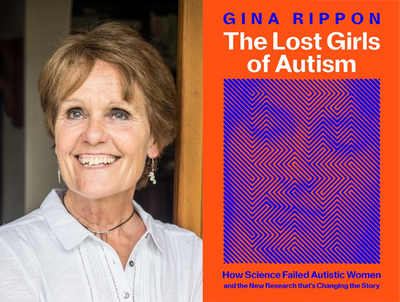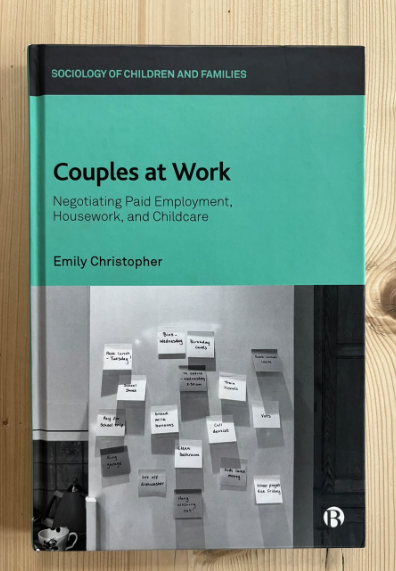Professor Gina Rippon signs a copy of The Lost Girls of Autism for talk attendee Dr Georgie Agar
- Professor Gina Rippon’s new book, The Lost Girls of Autism, investigates why autism was thought to be a male condition for so long
- She gave a public talk at Aston University on 6 May 2025 exploring the central themes of the book
- Women and girls with autism have long been overlooked as they are better at masking and camouflaging so ‘fail’ standard tests.
Autism in women and girls has been overlooked for decades, and Gina Rippon, professor emeritus of cognitive neuroimaging at Aston University Institute of Health and Neurodevelopment (IHN), has given a talk about her new book on the topic at Aston University.
The book, The Lost Girls of Autism, was released on 3 April 2025, coinciding with Autism Acceptance Month, with the subtitle ‘How Science Failed Autistic Women and the New Research that’s Changing the Story’.
Autism is characterised by a number of now well-known traits, including social awkwardness, extreme obsessions, and unusual movements and coping mechanisms known as ‘stimming’. It was (allegedly) first described in the 1940s separately by Austrian psychiatrists Leo Kanner and Hans Asperger. Originally identified as a rare developmental condition, since the 1980s, there has been an 800% increase in diagnoses, leading to concerns about an ‘autism epidemic’. There is a strong and enduring belief that it is a condition much more prevalent in males.
Professor Rippon described her research as “looking at how brains get to be different and what that means for the owners of those brains”. This includes looking at the functions of different areas of the brain using scanners.
During research into a number of brain conditions and diseases with obvious differences between the sexes, including how the disease progresses, such as Alzheimer’s in women, or prevalence in one particular sex, such as Parkinson’s in men, Professor Rippon also became interested in autism, also assumed to be largely a condition in males. However, during a research review, she found that many autism studies made no reference to sex differences. Amalgamated data from autism studies found that 80% of participants were male, and 25% of testing centres only tested males with autism. By only looking at males, Professor Rippon explained, the notion that autism is a male disorder became self-fulfilling.
This does not just refer to scientific research. Even now, boys are ten times more likely to be referred for assessment for autism and twice as likely to be diagnosed than girls, even when they have exactly the same traits. 80% of autistic females have received multiple wrong diagnoses, including borderline personality disorder, social anxiety or obsessive-compulsive disorder (OCD). But why? The reason is the unchallenged belief that ‘autism is a “boy” thing’ causing a male spotlight problem in all aspects of the autism story. It could also be that females with autism express the condition differently.
Professor Rippon said:
“This took me back to [my previous book] The Gendered Brain when I was looking at the very clear view of what males should be like and what females should be like. If you look at the autistic population you have this clear idea that males are like this, but females, er, not so much? Females have poor social skills, but not as poor, or obsessive interests, but not as obsessive, so the trouble with females, is that they are not autistic enough.”
The gold standard tests for autism are the Autism Diagnostic Observation Schedule (ADOS) and the Autism Diagnostic Interview (ADI) tests. Professor Rippon believes these are heavily biased towards how the condition manifests itself in males, such as social awkwardness or extreme obsessions. For example, parents may well be asked if their son has an unusual interest in weather patterns or train timetables, but they are not asked if their daughter has an unusual interest in Barbie dolls, because dolls are seen as socially acceptable.
Research has shown that females with autism are more likely to ‘camouflage’ their symptoms, watching how ‘normal people’ behave, even practising social interactions, so they appear more normal. They are also more likely to ‘mask’ symptoms behind a persona, such as the ‘class clown’ or ‘star athlete’, in an effort to fit in. Autistic females describe this behaviour as a ‘survival strategy’ to avoid being spotted as different.
It is also the case that girls are more likely to have sensory processing problems, such as aversion to strong smells, which can be enough to affect their day-to-day lives. This has only recently been added to the diagnostic criteria for autism. If the camouflaging or masking collapses, rates of other conditions such as disordered eating or anorexia, self-harm and gender dysphoria are disproportionately high, and it is these which will become identified as the underlying difficulty, rather than autism itself.
Professor Rippon said:
“The next stage should be asking why this group of individuals persists in hiding their autism, especially when autism has been defined as a lack of interest in social connection. There’s what I call the ‘born to be mild’ effect, where little girls are trained to socialise more, to behave, not to make a fuss, if you feel uncomfortable, don’t tell anyone else about it. There’s a lovely comment from one late-diagnosed female who rues the fact that she was so well behaved and wishes that she had just burned more cars so that someone would have spotted her carefully camouflaged distress!”
The final slide in the presentation covered what Professor Rippon called “an ironic footnote”. While Leo Kanner and Hans Asperger are described as the fathers of autism, writing in the 1940s, it was in fact a Soviet female psychiatrist, Grunya Sukhareva, writing in the 1920s, who first described autism, even clearly examining the differences in the condition between boys and girls. Why her research was ignored for so long is unclear, but the male spotlight problem may well have been avoided.
For more information about The Lost Girls of Autism, visit https://www.panmacmillan.com/authors/gina-rippon/the-lost-girls-of-autism/9781035011629.





